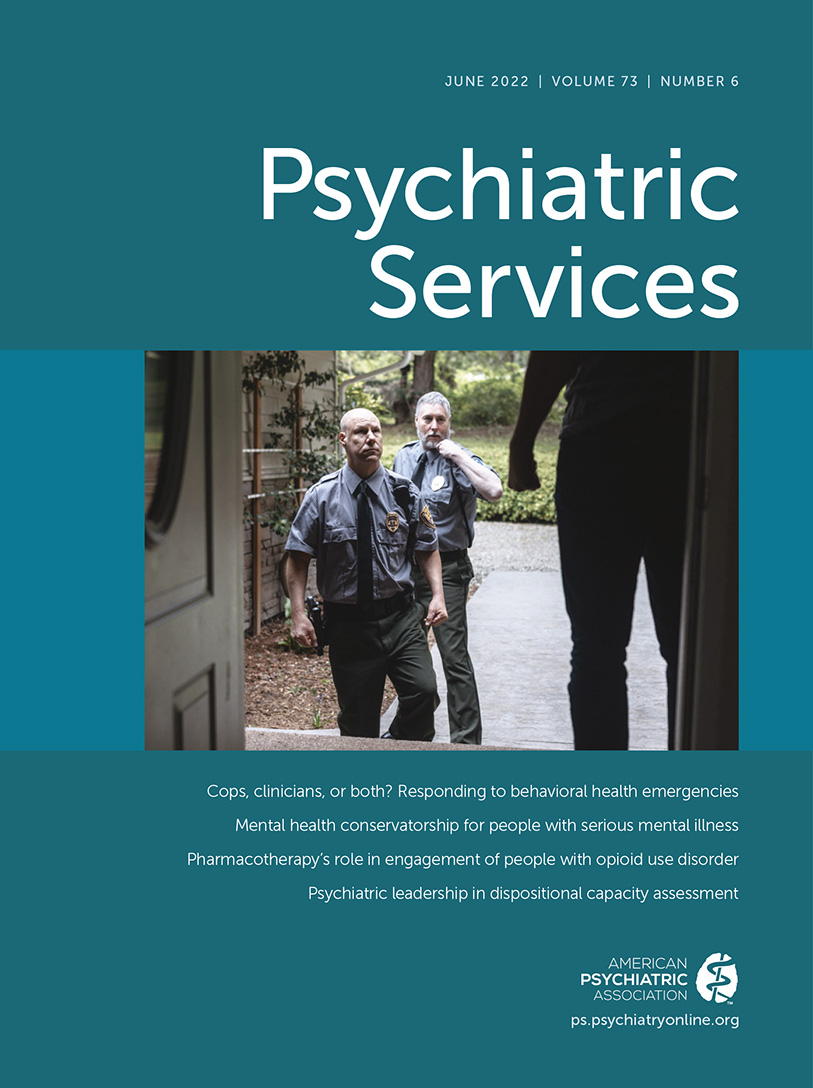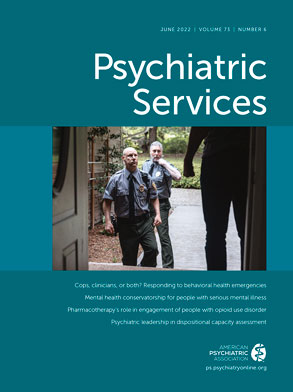Tony (not a real name; other details in the following vignette were altered to protect patient privacy) was an elderly man brought by ambulance to the emergency department. Upon arrival, he requested discharge. He did not have his home keys and was unable to provide basic information, including his address or collateral contacts. He was seen by an emergency psychiatrist, received oral and intramuscular antipsychotic medications for agitation, and was admitted to the internal medicine ward for delirium. The primary medicine team consulted a consultation-liaison psychiatry team for further assessment. The consultation team documented differential diagnoses of delirium and unspecified dementia, with rule-out diagnoses including opioid, benzodiazepine, and alcohol use disorders. The team’s recommendations included thiamine and folate supplementation, as-needed antipsychotic medications for agitation, monitoring for opioid and alcohol withdrawal, delirium precautions, and gathering collateral information about family, friends, and other close relations. The consultation team concluded that Tony lacked decisional capacity to leave against medical advice. They recommended that he be continuously monitored by both a clinical observer and a security guard.
Several days later, Tony continued to request discharge home. He eventually shared that his wife had recently died. He admitted to using heroin and illicit clonazepam before hospital presentation. He still could not recall his address or provide information about next of kin or friends. The psychiatry team completed a Montreal Cognitive Assessment (MoCA), which indicated a score of 18 of 30 (on a scale where higher scores indicate better cognition), with particular deficits in executive function. A CT scan of the head revealed mild-to-moderate volume loss in the brain. The primary medicine team then asked the consulting psychiatry team to comment on Tony’s capacity to safely discharge home. The psychiatry team declined to comment, reasoning that such a future-oriented and multivariate assessment could not be made with the limited clinical data available. The psychiatry team recommended occupational therapy assessment and again encouraged the primary medicine team to obtain collateral information. An occupational therapist completed a Kettle Test, on which Tony scored 7 of 52 (higher scores indicate greater cognitive impairment). Ultimately, the primary medicine team contacted Tony’s neighbor, who confirmed that she had called 911 after finding Tony in an unresponsive state. Tony was medically cleared, given a naloxone prescription, and discharged with transportation directly home. He declined substance use rehabilitation treatment. Social work referred him to visiting nursing services and a home health aide.
Dispositional Capacity in Practice
Psychiatrists routinely complete decisional capacity assessments. Appelbaum’s criteria (
1) guide questioning and documentation of a patient’s ability to communicate choice, understand information, appreciate consequences, and reason through options. These assessments are unidimensional and cross-sectional; they gauge capacity to make a discrete, binary decision at present. Bourgeois et al. (
2,
3) coined the term
dispositional capacity in 2017. The term is defined as “the assessment to determine the patient’s capacity for self-management postdischarge” (
2). Dispositional capacity is multifactorial and prospective and involves envisioning a patient’s ability to care for self in the community and in the future.
Researchers have developed tools that aid clinicians when considering discharge options for hospitalized patients. Although no formal guidelines specify which cognitive assessment to use, clinicians often refer to the MoCA or the Folstein Mini-Mental State Examination. Functional assessments include the Assessment of Capacity for Everyday Decision-Making, MacArthur Competency Assessment Tool for Treatment, Langley-Porter Physical Self-Maintenance Scale, and the Instrumental Activities of Daily Living Scale (
4,
5).
Bourgeois et al. (
2) state that, “It is timely to more fully integrate a standard approach to cases presenting with concerns over decisional capacity and dispositional capacity. A clinical practice of . . . ‘only answering the [decisional] capacity question’ is limited and problematic, and represents a lost opportunity to fully engage in comprehensive patient care.” This view echoes calls from geriatric care clinicians to develop formal metrics for capacity assessments (
6). It also illuminates disposition dilemmas such as Tony’s, in which primary medical and social work teams do not have a defined clinical pathway to follow. There are clear opportunities here for psychiatric involvement in making decisional capacity assessments, synthesizing biopsychosocial data, recommending cognitive and functional assessments, and coordinating multiteam disposition efforts. This is particularly the case for patients who lack decisional capacity and are without designated surrogates or advance directives. This population currently comprises 16% of intensive care patients and 3% of nursing home residents (
7).
Social Theory and Dispositional Capacity Assessment
We argue that psychiatrists should own, rather than defer, the responsibilities of dispositional capacity assessment. Perspectives from social theory and the psychiatric literature provide theoretical context for this complex issue. Sociologist Emile Durkheim’s (
8) notion of anomie is pertinent to this discussion. Anomie refers to a mismatch between individual action and social norms. The anomic individual does not or is unable to ascribe to the oft-unspoken social ethic. The individual thus repeatedly breaks moral and legal standards (
9). The unspoken and unable aspects of anomie are further elucidated by social theories of governmentality and biopower. Fundamentally, these theories refer to a person’s ability to internalize social standards in a way that allows for self-governance of health and well-being—that allows an individual to function independently without significant external aid (
10).
In cases like Tony’s, part of what unsettles us as physicians interested in efficient treatment and discharge, is that an anomic individual, such as an elderly person with delirium, likely dementia, a history of substance use, precarious social connections, and a questionable ability to self-govern, has presented to the hospital. Tony is without kinship—the solidarity “mediated by blood and marriage” (
9)—that connects a person to beholden others, provides “the first line of defense against misfortune” (
9), and serves as the foundation for national social security. Fortunately, Tony has a collection of what Columbia anthropologist Kim Hopper (
9) refers to colloquially as “but fors.” These “but fors” include the solicitousness of a neighbor and the diligence of the hospital providers. These connections constitute the difference between his marginal status and life in a “zone of social abandonment” (
11)—what Princeton anthropologist João Biehl (
11) describes as “places where the mentally ill and homeless, . . . the unproductive young, and old bodies” live and die.
In clinical cases where “organic impairment and past history interfere and pose a threat to health,” dilemmas frequently arise regarding how to preserve autonomy (
12,
13). Cohen et al. (
12) exemplify this dilemma when they bluntly state that the “elderly, noncompliant rootless individual” can be “impossible to treat.” Hamann et al. (
14) echo that statement by observing, “The combination of marked participation preferences and impairments in the decisional capacity of individuals with aMCI [amnestic mild cognitive impairment] and early AD [Alzheimer’s disease] constitute an ethical and practical challenge.” Auerswald et al. (
15) add that “delirium poses unique ethical challenges to the informed consent process, notably the preservation of patient autonomy in the face of potentially fluctuating decision-making capacity.” This is especially true in cases of delirium superimposed on premorbid dementia, a relatively common presentation in hospitalized individuals ages >65 (
16,
17). Of note, the delirium overlay is often preventable with reasonable precautions, including orientation, mobilization, and avoidance of psychoactive medications (
17). Perhaps, psychiatric involvement through dispositional capacity assessment could provide a space to acknowledge and ameliorate such dilemmas.
An Opportunity for Psychiatric Leadership
What are the clinical possibilities for advancing Bourgeois et al.’s (
2) foundational work and developing dispositional capacity criteria akin to that of Appelbaum’s (
1) decisional capacity criteria? This development might entail a codified, encompassing mix of qualitative and quantitative data that allow clinicians to make assessments that can be communicated across practice settings (i.e., psychiatry to internal medicine), hospital, and regional contexts. A start could be delineating a practical clinical pathway for making such assessments (see table in an
online supplement to this Open Forum). As Bourgeois et al. (
2) advocate, dispositional capacity assessment might be conceptualized as comprising both decisional and performative components. In addition to weighing the risks and benefits of home versus another disposition, clinicians should be aware that a patient would need to demonstrate adequate cognitive and functional skills before being discharged home.
To begin such an assessment, a psychiatrist could complete a psychiatric evaluation, decisional capacity assessment, and formal cognitive testing (e.g., MoCA). A social worker could obtain clinically relevant information about past function and possibly perform an in situ evaluation (e.g., a home visit). Occupational and physical therapists could tailor their assessments to comment on a patient’s ability to complete activities of daily living. The treatment teams could then convene to discuss an appropriate disposition to match the patient’s cognitive and physical capacities. The psychiatrist could document the dispositional capacity assessment, including a synthesis of the above data. The primary team physician, if different from the assessing psychiatrist, could make the final dispositional decision. The social worker could then arrange aftercare. With further research, perhaps patients could be assigned quantitative disposition scores, which could be compared with evidence-based average scores for different dispositions.
What are the potential implications for psychiatry in taking a leading role in this effort? Beyond filling a functional clinical role, dispositional capacity assessment has potential as an intervention on social determinants of health. It is a concrete procedure that can connect individualized patient care to broader calls for social inquiry. With a holistic dispositional capacity assessment, the psychiatrist has an opportunity to pause and convene a multidisciplinary team. They can consider the ways in which not only financial means and social supports but also factors such as race and gender might affect a patient’s postdischarge trajectory. Engaging in such a value-driven, protocolized, and team-based assessment could both decrease stress of primary medicine teams around discharge and thoughtfully match patients with complex neuropsychiatric conditions to disposition options.
Although some providers within psychiatry may prefer to defer dispositional capacity assessments to social work, dilemmas regarding the balance between autonomy and beneficence will continue to emerge in routine clinical care. Social workers are experts in identifying social supports and arranging aftercare. Psychiatrists are uniquely trained in performing decisional capacity assessments, developing differential diagnoses, and providing treatments. These decisional and clinical assessments are central to dispositional capacity determination. As default team leaders and clinical experts, psychiatrists should consider researching, codifying, and disseminating dispositional capacity criteria.

